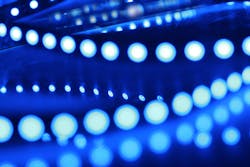Nobel Prize for Physics Awarded for Invention of Blue LED
Japanese scientists Isamu Akasaki and Hiroshi Amano and American Shuji Nakamura won the 2014 Nobel Prize for Physics for inventing the blue LED.
"In the spirit of Alfred Nobel the Prize rewards an invention of greatest benefit to mankind; using blue LEDs, white light can be created in a new way. With the advent of LED lamps we now have more long-lasting and more efficient alternatives to older light sources," the Royal Swedish Academy of Sciences said in a statement.
When Isamu Akasaki, Hiroshi Amano and Shuji Nakamura produced bright blue light beams from their semi-conductors in the early 1990s, they triggered a fundamental transformation of lighting technology. Red and green diodes had been around for a long time but without blue light, white lamps could not be created. Despite considerable efforts, both in the scientific community and in industry, the blue LED had remained a challenge for three decades.
They succeeded where everyone else had failed. Akasaki worked together with Amano at Nagoya University, while Nakamura was employed at Nichia Chemicals, a small company in Tokushima. Their inventions were revolutionary. Incandescent light bulbs lit the 20th century; the 21st century will be lit by LED lamps.
White LED lamps emit a bright white light, are long-lasting and energy-efficient. They are constantly improved, getting more efficient with higher luminous flux (measured in lumen) per unit electrical input power (measured in watt). The most recent record is just over 300 lm/W, which can be compared to 16 for regular light bulbs and close to 70 for fluorescent lamps. As about one fourth of world electricity consumption is used for lighting purposes, the LEDs contribute to saving the Earth's resources. Materials consumption is also diminished as LEDs last up to 100,000 hours, compared to 1,000 for incandescent bulbs and 10,000 hours for fluorescent lights.
The LED lamp holds great promise for increasing the quality of life for over 1.5 billion people around the world who lack access to electricity grids: due to low power requirements it can be powered by cheap local solar power.
"The invention of the blue LED is just 20 years old, but it has already contributed to create white light in an entirely new manner to the benefit of us all," the Royal Swedish Academy of Sciences said.
Noah Horowitz, a blogger for the Natural Resources Defense Council, wrote after the award that the switch from inefficient incandescent light bulbs to LEDs has just begun in the United States and is on track to cut our nation’s electricity bill by more than $13 billion annually and save enough electricity each year to power all the homes in Texas.
"Those of us working to convert our economy to a clean energy future and reduce emissions of climate-changing pollution are deeply indebted and proud of these three brilliant scientists who won this award," Horowitz wrote.
Isamu Akasaki, Japanese citizen. Born 1929 in Chiran, Japan. Ph.D. 1964 from Nagoya University, Japan. Professor at Meijo University, Nagoya, and Distinguished Professor at Nagoya University, Japan.
Hiroshi Amano, Japanese citizen. Born 1960 in Hamamatsu, Japan. Ph.D. 1989 from Nagoya University, Japan. Professor at Nagoya University, Japan.
Shuji Nakamura, American citizen. Born 1954 in Ikata, Japan. Ph.D. 1994 from University of Tokushima, Japan. Professor at University of California, Santa Barbara, CA, USA.
Prize amount: SEK 8 million, to be shared equally between the Laureates.
